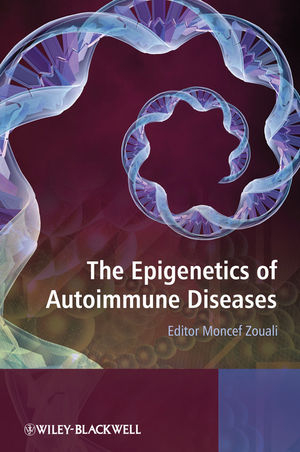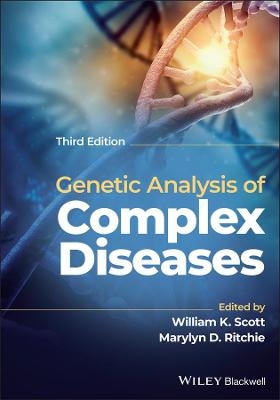
The Epigenetics of Autoimmune Diseases
Wiley-Blackwell (Verlag)
978-0-470-75861-8 (ISBN)
- Titel ist leider vergriffen;
keine Neuauflage - Artikel merken
This book is an essential resource for those actively involved in the field. It is also of interest to basic researchers interested in understanding the origin of autoimmunity and clinical specialists interested in gaining in-depth understanding of the pathogenesis of autoimmune diseases and their treatment.
MONCEF ZOUALI, Institut National de la Recherche et de la Santé Médicale (INSERM), France.
Contributors. PART I: TRANSCRIPTION FACTORS: PARTNERS OF IMMUNE TOLERANCE TO SELF. 1. Transcriptional Regulation of T Cell Tolerance (Brian T. Abe, Ayana Jordan, Vanessa M. Hubbard and Fernando Macian). 1.1 Introduction. 1.2 T cell anergy. 1.3 Ca2+/calcineurin/NFAT signalling in T cell anergy. 1.4 Transcriptional programme of T cell anergy. 1.5 Transcriptional repression in T cell anergy: epigenetic modification of the Il2 promoter. 1.6 Regulatory T cells. 1.7 Transcriptional control of Treg development and function. References. 2. Epigenetic Regulation of Foxp3 Expression in Regulatory T Cells (Julia K. Polansky, Stefan Floess, Jennifer Freyer, Alf Hamann and Jochen Huehn). 2.1 Introduction. 2.2 Naturally occurring CD25+CD4+ Tregs. 2.3 The transcription factor FOXP3: determining Treg function and identity. 2.4 Molecular regulation of FOXP3. 2.5 Tregs as a stable lineage: indications of epigenetic imprinting. 2.6 Induced Tregs: stable suppressors or transient immuno-modulators? 2.7 Conclusions. References. 3. The Role of NF-kB in Central Tolerance (Mingzhao Zhu, Matthew Ruddy and Yang-Xin Fu). 3.1 Introduction. 3.2 Canonical and alternative NF-kB pathways. 3.3 Thymic stroma and central tolerance. 3.4 NF-kB and regulatory T cell development. 3.5 NF-kB and thymocyte positive and negative selection. 3.6 Conclusions and perspectives. 3.7 Acknowledgement. References. 4. The Role of Act1 in the Control of Autoimmunity (Trine N. Jorgensen, Natalia V. Giltiay, Angela Johnson and Xiaoxia Li). 4.1 Introduction. 4.2 Autoimmunity and autoimmune mouse models. 4.3 Molecular mechanisms of autoimmunity. 4.4 Act1: a modulator of autoimmunity. 4.5 Conclusions. References. 5. Regulation of T Cell Anergy and Escape from Regulatory T Cell Suppression by Cbl-b (Stefanie Loeser and Josef M. Penninger). 5.1 Introduction. 5.2 Mechanisms of T cell tolerance induction. 5.3 Molecular establishment of T cell anergy. 5.4 Ubiquitin E3 ligases in T cell tolerance. 5.5 Molecular function and regulation of Cbl-b. 5.6 Physiological relevance of Cbl-b. 5.7 The role of Cbl-b in T cell tolerance. 5.8 Deregulation of Cbl-b in disease. 5.9 Therapeutic potential of Cbl-b in tumour immunity. 5.10 Implications for autoimmune disease. References. 6. Indoleamine 2,3-dioxygenase: Transcriptional Regulation and Autoimmunity (Maria Laura Belladonna, Ciriana Orabona, Claudia Volpi, Ursula Grohmann, Paolo Puccetti and Maria Cristina Fioretti). 6.1 Introduction. 6.2 L-Trp degradation along the kynurenine pathway and immune functions of IDO. 6.3 IDO immunobiology and therapeutic intervention. 6.4 Transcriptional regulation of the IDO-encoding gene. 6.5 Impaired IDO activity and loss of tolerance in autoimmune diseases. 6.6 IDO-based therapies for autoimmune disease. 6.7 Acknowledgement. References. PART II: STRESS RESPONSES THAT BREAK IMMUNE SILENCE. 7. Chromatin Modifications, Oxidative Stress and Nucleosome Autoantibodies (Annika Erbacher and Patrice Decker). 7.1 Introduction. 7.2 Nucleosome and SLE. 7.3 Epigenetics and SLE. 7.4 Oxidative stress in SLE: definition and mechanisms. 7.5 Oxidative stress, epigenetic alterations and nucleosome immunogenicity. 7.6 Conclusion. 7.7 Acknowledgements. References. 8. Stress, Epigenetics and Thyroid Autoimmunity (Agathocles Tsatsoulis). 8.1 Introduction. 8.2 The Th1/Th2 balance in immune-response regulation. 8.3 Stress hormones and the Th1/Th2 balance. 8.4 The Th1/Th2 balance in thyroid autoimmunity. 8.5 Association of stress with thyroid autoimmunity. 8.6 Stress in the clinical expression of thyroid autoimmunity: a unifying hypothesis. 8.7 Epigenetic regulation of T cell differentiation and stress hormones. 8.8 Conclusions. References. 9. Reactive Intermediates, Inflammation and Epigenetics in Lupus (Gary S. Gilkeson and Jim C. Oates). 9.1 Introduction. 9.2 Biology of reactive intermediates. 9.3 RNIs in murine models of lupus. 9.4 Genetic associations of RNI/ROI and lupus. 9.5 Conclusions. References. 10. Post-translational Modification of HMGB1 and Its Role in Immune Activation (Anirudh J. Ullal and David S. Pisetsky). 10.1 Introduction. 10.2 Molecular biology of HMGB1. 10.3 HMGB1 as an immune mediator. 10.4 Mechanisms of HMGB1 modification and release. 10.5 The role of HMGB1 as a mediator of disease and target of therapy. 10.6 Conclusion. References. 11. Idiosyncratic Drug-Induced Liver Injury: Facts and Perspectives (Jos'. V. Castell and Isabel Minana). 11.1 Introduction. 11.2 Intrinsic drug toxicity to the liver. 11.3 Idiosyncratic drug toxicity to the liver. 11.4 Mechanisms of hypersensitivity reactions to drugs in the liver. 11.5 Hypersensitivity versus tolerance. 11.6 Hepatocyte injury as a consequence of allergic hepatitis. 11.7 Drug-induced liver autoimmunity. 11.8 Epigenetics of drug-induced liver injury. 11.9 Acknowledgements. References. PART III: EPIGENETIC MODIFIERS OF AUTOIMMUNITY. 12 Epigenetic Modifications Associated with T Cell Tolerance (Andrew D. Wells and Rajan M. Thomas) . 12.1 Immunity versus tolerance. 12.2 Epigenetic regulation of the physical structure of genomic DNA. 12.3 Epigenetic control of pro-inflammatory cytokine gene transcription. 12.4 Epigenetic silencing of cytokine genes in tolerant T cells. 12.5 Targeting epigenetic modifications to cytokine genes in tolerant T cells. 12.6 Common mechanisms of epigenetic silencing among distinct types of tolerant T cells? References. 13. DNA Methylation Alterations in Systemic Lupus Erythematosus (Biola M. Javierre, Manel Esteller and Esteban Ballestar). 13.1 Introduction. 13.2 DNA methylation: an epigenetic determinant of lymphocyte function. 13.3 DNA methylation changes in lupus. 13.4 Epigenetic regulation as a therapeutic target. 13.5 Future aims for epigenetic research into lupus. 13.6 Acknowledgements. References. 14 Long-Range Histone Acetylation Patterns in the Development of Autoimmunity (Thomas M. Aune, Shaojing Chang and Weisong Zhou). 14.1 Introduction. 14.2 The histone code hypothesis. 14.3 Epigenetic defects as a mechanism of disease. 14.4 Analysis of the histone code. 14.5 Long-range histone acetylation patterns in Th cell differentiation. 14.6 Long-range histone acetylation and autoimmunity. 14.7 Perspectives. 14.8 Acknowledgements. References. 15. Roquin Defects Reveal a Role for the microRNA Machinery in Regulating Autoimmunity (Di Yu and Carola G. Vinuesa). 15.1 Introduction. 15.2 RNA silencing through the miRNA machinery. 15.3 miRNAs regulate lymphoid cell development and immune responses. 15.4 miRNAs as single drivers of immunodeficiency or inflammation. 15.5 miRNAs regulate autoimmunity. 15.6 Roquin regulates miRNA-mediated silencing of T cells and represses lupus. 15.8 Concluding remarks. 15.9 Acknowledgements. References. 16. Autoimmune Response to Post-translationally Modified (Citrullinated) Proteins: Prime Suspect in the Pathophysiology of Rheumatoid Arthritis (Mireille Sebbag, Cyril Clavel, Leonor Nogueira, Jacques Arnaud and Guy Serre). 16.1 Introduction. 16.2 RA is associated with B cell autoreactivity to citrullinated proteins. 16.3 Both ACPA and citrullinated antigenic targets are present in the RA synovium. 16.4 Autoreactivity to citrullinated proteins probably plays a role in RA synovitis. 16.5 The way ACPA could promote joint inflammation. 16.6 Joint-expressed citrullinated autoantigen targets possibly involved in a pro-inflammatory effect of ACPA. 16.7 Initial triggering of the autoimmune response to citrullinated proteins. 16.8 Goals for future research. 16.9 Acknowledgements. References. 17. Hormones: Epigenetic Contributors to Gender-Biased Autoimmunity (Virginia Rider and Nabih I. Abdou). 17.1 Introduction. 17.2 Oestrogen receptors. 17.3 Oestrogen and autoimmunity. 17.4 Foxp3 and ERs. 17.5 ERs and histone modifications. 17.6 The histone code. 17.7 Co-activators. 17.8 Pioneer factors. 17.9 Co-repressors. 17.10 ERs and cell proliferation. 17.11 Epigenetic changes in disease. 17.12 ERs and SLE. 17.13 Co-activators and phosphorylation. 17.14 Endocrine disruptors. 17.15 Perspectives and future directions. 17.16 Acknowledgements. References. 18. Epigenetics and Systemic Sclerosis (Serena Guiducci and Marco Matucci Cerinic). 18.1 Introduction. 18.2 Vascular alterations in SSc. 18.3 Tissue hypoxia, oxidative stress and SSc. 18.4 Respiratory burst and post-translational modifications in SSc. 18.5 The epigenome and its environmental reprogramming. 18.6 Epigenetics and SSc. 18.7 Conclusions. References. 19. Epigenetic Regulation of B Lymphocyte Development and Repertoire Selection: Relevance to Autoimmunity (Moncef Zouali). 19.1 Introduction. 19.2 Initiation of B cell fate choice. 19.3 Checkpoints of B cell tolerance to self. 19.4 Negative regulation of immunoglobulin gene joining. 19.5 B cell fate commitment and immunoglobulin gene accessibility. 19.6 Changes in chromatin structure during B cell development. 19.7 Epigenetic changes through association of different immunoglobulin loci. 19.8 Epigenetic factors that allow full utilization of the immunoglobulin repertoire. 19.9 Multistep regulation of B cell maturation. 19.10 Altered B cell functions in systemic autoimmunity. 19.11 Impaired B cell tolerance to self in systemic autoimmunity. 19.12 Epigenetic factors underlying impaired B cell tolerance. 19.13 Future prospects. 19.14 Acknowledgement. References. PART IV: TOWARDS NOVEL EPIGENETIC-BASED IMMUNO-INTERVENTION STRATEGIES IN AUTOIMMUNE DISEASE. 20. Protective Effects of Epigenetic Modifications in Experimental Inflammatory Bowel Disease (Rainer Glauben, Elena Sonnenberg and Britta Siegmund). 20.1 Introduction. 20.2 Mechanisms of protein acetylation and deacetylation. 20.3 Anti-inflammatory effect of epigenetic modifications in vitro. 20.4 Impact of HDAC inhibition in models of experimental colitis. 20.5 Perspectives. References. 21. Epigenetic Regulation of Autoimmune Diseases through Deacetylase Inhibition (Bin Li, Yuan Shen, Zhaocai Zhou, Xiaomin Song, Kathryn Bembas, Xiao Yun Zhao, Zheng Cai, Alan Berezov, Sandra J. Saouaf, Hongtao Zhang, Qiang Wang and Mark I. Greene). 21.1 Introduction. 21.2 Regulatory T cells. 21.3 Epigenetic regulation of FOXP3 expression. 21.4 FOXP3 acetylation and function. 21.5 Protein lysine deacetylation. 21.6 HDAC inhibitors in autoimmune disease. 21.7 Dietary butyrate promotes lysine acetylation by inhibiting deacetylases. 21.8 The HDAC inhibitor butyrate affects TGF-beta signalling and increases Smad3 levels. 21.9 HDAC inhibitors affect immune-cell proliferation and conversion of antigen triggered T cells into an unresponsive state. 21.10 Conclusions. References. 22. Histone Deacetylases and Autoimmunity (Andras Treszl, Gerg&o Meszaros, Gergely Toldi and Barna Vasarhelyi). 22.1 Introduction. 22.2 Chromatin acetylation and deacetylation. 22.3 Histone deacetylases and histone acetyltransferases. 22.4 Histone acetylation, deacetylation and transcription factors in autoimmunity. 22.5 Acetylation state and lymphocyte functions. 22.6 HDACs and their inhibition in autoimmune disease. 22.7 Conclusions. 22.8 Acknowledgements. References. 23. Histone Deacetylase Inhibitors as a Therapeutic Modality in Multiple Sclerosis (Steven G. Gray). 23.1 Introduction. 23.2 Linking the histone code with MS. 23.3 Neuronal traits are modulated by HDAC transcription factor complexes. 23.4 Motor neurone genes modulated by HDACs. 23.5 The transcription factor E2F1, HDACs and neuronal survival mechanisms. 23.6 HDACs play important roles in stem cell neuronal differentiation. 23.7 HDIs lead to acetylation of the Sp1 transcription factor. 23.8 Immune-system effects of HDIs. 23.9 HDACs and pro-inflammatory and stress-related pathways in immune settings. 23.10 HATs, HDACs and the NF-kB pathway. 23.11 HATs, HDACs and ER stress. 23.12 Clinical trials and caveats of HDIs. 23.13 Do HDIs target genes or help chaperone activity as their primary response? 23.14 Future directions. References. Index.
| Erscheint lt. Verlag | 1.10.2009 |
|---|---|
| Verlagsort | Hoboken |
| Sprache | englisch |
| Maße | 174 x 252 mm |
| Gewicht | 954 g |
| Einbandart | gebunden |
| Themenwelt | Studium ► 2. Studienabschnitt (Klinik) ► Humangenetik |
| Studium ► Querschnittsbereiche ► Infektiologie / Immunologie | |
| Naturwissenschaften ► Biologie ► Genetik / Molekularbiologie | |
| ISBN-10 | 0-470-75861-9 / 0470758619 |
| ISBN-13 | 978-0-470-75861-8 / 9780470758618 |
| Zustand | Neuware |
| Informationen gemäß Produktsicherheitsverordnung (GPSR) | |
| Haben Sie eine Frage zum Produkt? |
aus dem Bereich


